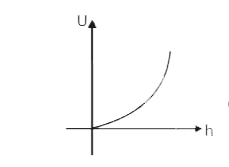A particle of mass an charge q is projected vertically upwards .A uniform electric field →E is acted vertically downwards.The most appropriate graph between potential energy U (gravitation plus electrostatic) and height h(<< radius of earth) is :(assume U to be zero on surface of earth)




The correct Answer is:A
Step by step video, text & image solution for A particle of mass an charge q is projected vertically upwards .A uniform electric field vec(E) is acted vertically downwards.The most appropriate graph between potential energy U (gravitation plus electrostatic) and height h(lt lt radius of earth) is :(assume U to be zero on surface of earth) by Physics experts to help you in doubts & scoring excellent marks in Class 12 exams.
Updated on:21/07/2023Topper's Solved these Questions
- ELECTROSTATICS - I BOOK - MOTIONCHAPTER - ELECTROSTATICS - I EXERCISE - EXERCISE - 1 (Section D)
8 Videos
- ELECTROSTATICS - I BOOK - MOTIONCHAPTER - ELECTROSTATICS - I EXERCISE - EXERCISE - 1 (Section E)
15 Videos
- ELECTROSTATICS - I BOOK - MOTIONCHAPTER - ELECTROSTATICS - I EXERCISE - EXERCISE - 1 (Section B)
10 Videos
- ELECTROSTATICSBOOK - MOTIONCHAPTER - ELECTROSTATICSEXERCISE - Exercise -3 Section (B) Previous Year Problems | JEE Main
30 Videos
- ELECTROSTATICS-IIBOOK - MOTIONCHAPTER - ELECTROSTATICS-IIEXERCISE - Exercise - 4 (Level - II)
30 Videos
Similar Questions
A particle is having mass m & charge +q is projected horizontally from point O. Electric field is present and is directed vertically downward .
View SolutionA particle of mass m and charge q is released from rest in uniform electric field of intensity E. Calculate the kinetic energy it attains afect moving a distance x between the plates.
View Solution
Knowledge Check
A particle of mass an charge q is projected vertically upwards .A uniform electric field →E is acted vertically downwards.The most appropiate graph between potential energy U (gravitaion plus eelectrostatic) and height h(lt lt radius of earth) is :(assume U to be zero on surface of earth)
A B
B C
C D
D
A particle of mass m and charge −q is released from rest in a uniform electric field. If there is no other force on the particle, the dependence of its potential energy on the distance x travelled by it is correctly given by (assume initial potential energy to be zero ,graphs are schematic and not drawn to scale)
A B
B C
C D
D
A particle of mass m is projected upwards with velocity v=ve2, where ve is the escape velocity then at the maximum height the potential energy of the particle is : (R is radius of earth and M is mass of earth)
A−GMm2RB−GMm4RC−3GMm4RD−2GMm3R
A particle of mass m and charge q is thrown at a speed u against a uniform electric field E. How much distance will it travel before coming to momentary rest?
View SolutionA very small particle of mass m and charge q is given an initial speed u against uniform electric field E. How much distance will the particle cover before acquiring the same speed again?
View SolutionBetween two horizontal parallel plates, uniform electric field E directed vertically downward. A charged particle (q,m) remains in equilibrium in vaccum between the plates. Find shortage/excess of electrons in the charged particle .
View SolutionA simple pendulum consists of a small sphere of mass m suspended by a thread of length l. The sphere carries a positive charge q. The pendulum is placed in a uniform electric field of strength E directed vertically downwards. Finds the period of oscillation of the pendulum due to the electrostatic force acting on the sphere, neglecting the effect of the gravitational force.
View SolutionGravitational potential energy of body of mass m at a height of h above the surface of earth (M = mass of earth , R = radius of earth) is
View Solution
